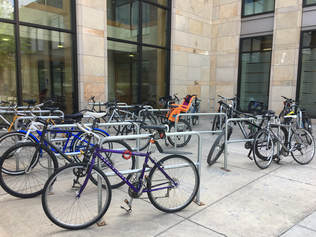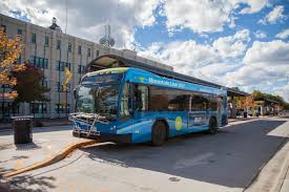|
As a former Midwesterner and a two-month-old Missoulian, I was excited to talk and connect with community members at Climate Smart’s Monthly meetup on transportation. As I began navigating my new home in pursuit of used furniture and cheap bulk foods, I was excited to see the level of accessibility Missoula provides (zero-fare buses, wow!) but also acknowledged ways it can improve (what’s up with the tiny walkway on the Higgins Bridge?). Our conversation on transportation this month echoed that feeling of hope and excitement at what has already been accomplished, as well as reminded all of us of what work we can still do to make our community more sustainable and healthy.  With a room full of experts, there’s so much to discuss with so little time. Much of our conversation focused on ways the city was (or should) be transitioning its streets into more walkable and bikeable avenues for the community. Missoula has been developing its public transportation infrastructure since the 1970’s, which luckily allows plenty of room for green development. Bob Giordano, the director of Free Cycles and the Missoula Institute for Sustainable Transportation, discussed the idea of “complete streets,” streets that are usable for all people, no matter their form of transportation or accessibility needs (cars, bikes, crosswalks, sidewalk ramps, etc.). He also talked about “road diets,” decreasing the number of lanes on a street, and how they provide benefits for all commuters, whether driving a car or riding a bike. He along with Aaron Wilson, a Transportation Planner with the City of Missoula, emphasized that we’ve done a lot to develop these types of infrastructure, but there are always ways we can improve. Giordano brought up many exciting opportunities for community engagement in our city’s transportation decisions. This fall, the city council will be voting on whether to shift 5th and 6th streets from a two-lane road to one, with a buffered bike lane. (Head here for more info.) This will increase bike and pedestrian safety without cutting down travel times for car drivers. The vote is happening at the council meeting at 7pm on Monday, December 3rd in City Council Chambers --feel empowered to come share your voice or simply be there for support! The issue will be heard in committee the previous Wednesday (11/28), and supporters would also be welcome there. Please email Bob directly if you have further questions about how to be involved - and we’ll also do our best to remind you of these opportunities for action. Additionally, the first open community meeting of the year on the revitalization of the city’s Downtown Master Plan is happening October 18th at 5:30 pm at the Wilma Theater. The master plan is a comprehensive strategy set to strengthen and invigorate Missoula’s downtown into the economic and cultural center of the city; it covers everything from housing and retail to transportation and parking. This will be a great opportunity to hear how downtown Missoula might be changing in the coming decades--come share your vision! If you want to get more involved in how transportation will look in the updated plan, consider joining the Transportation Focus Group starting in mid-October. Contact Bob Giordano at [email protected] for details. Did you know that we are in the Top 10 list for biking accessibility in U.S. communities our size? How cool is that! And we’re not finished yet. As part of Missoula’s Long Range Transportation Plan, the city has committed to an ambitious mode split by 2045 that would triple the number of bikers, walkers, and public transit users while cutting the number of drive-alone commuters by about 30%. Not only does this increase road safety and community health, but it also decreases the amount of greenhouse gas emissions our community is releasing into the atmosphere. Are you interested in shifting your commuter mode of travel but you don’t know how? Katherine Auge, Missoula in Motion’s program specialist, told us all about the organization’s exciting program, Way to Go! Missoula. By simply entering your starting and ending points on their website, you’ll be provided with information on all the different modes of transportation and routes you can use to safely arrive at your destination including distance, travel time, and the pounds of carbon that are emitted from your chosen method (hint: biking and walking emit zero!). This includes ride-sharing or carpooling opportunities. You can also participate in the organization’s Commuter Challenge to motivate those at your workplace to try a different mode of commuting to work every day.  Photo credit: Mountain Line Photo credit: Mountain Line Not only do Missoulians bike, but we love our public transit. Ever since the Mountain Line Bus system went zero-fare in 2015, ridership has increased 70 percent! Vince Caristo, Mountain Line’s Project Management Specialist, filled us in on some of the exciting developments they are considering for the bus line. More expansive routes as well as buses running on Sundays were a few of the possibilities he mentioned. Mountain Line is currently strategizing to expand their services even further. Check out this recent article in the Missoula Current for more details on what Mountain Line’s future could look like. The meetup made it clear that Missoula is passionate about transportation and accessibility. Not only does a diverse transportation mix lead to better environmental and community health, but it just as importantly provides options and amenities for low-income, disabled, and elderly community members. Providing better and safer transportation options for everyone is important for the prosperity of our beautiful city.
I was as excited as anyone about our conversation. I’m happy to be here in an engaged community with such ambitious goals for safety, sustainability, and health. Join us next month for a discussion on how to develop Missoula’s economic prosperity in a sustainable, equitable way. I know I’ll be there! -Anna Weinberg, Energy and Climate Educator
2 Comments
|
AuthorsAbby Huseth Archives
July 2024
Categories
All
|

 RSS Feed
RSS Feed


